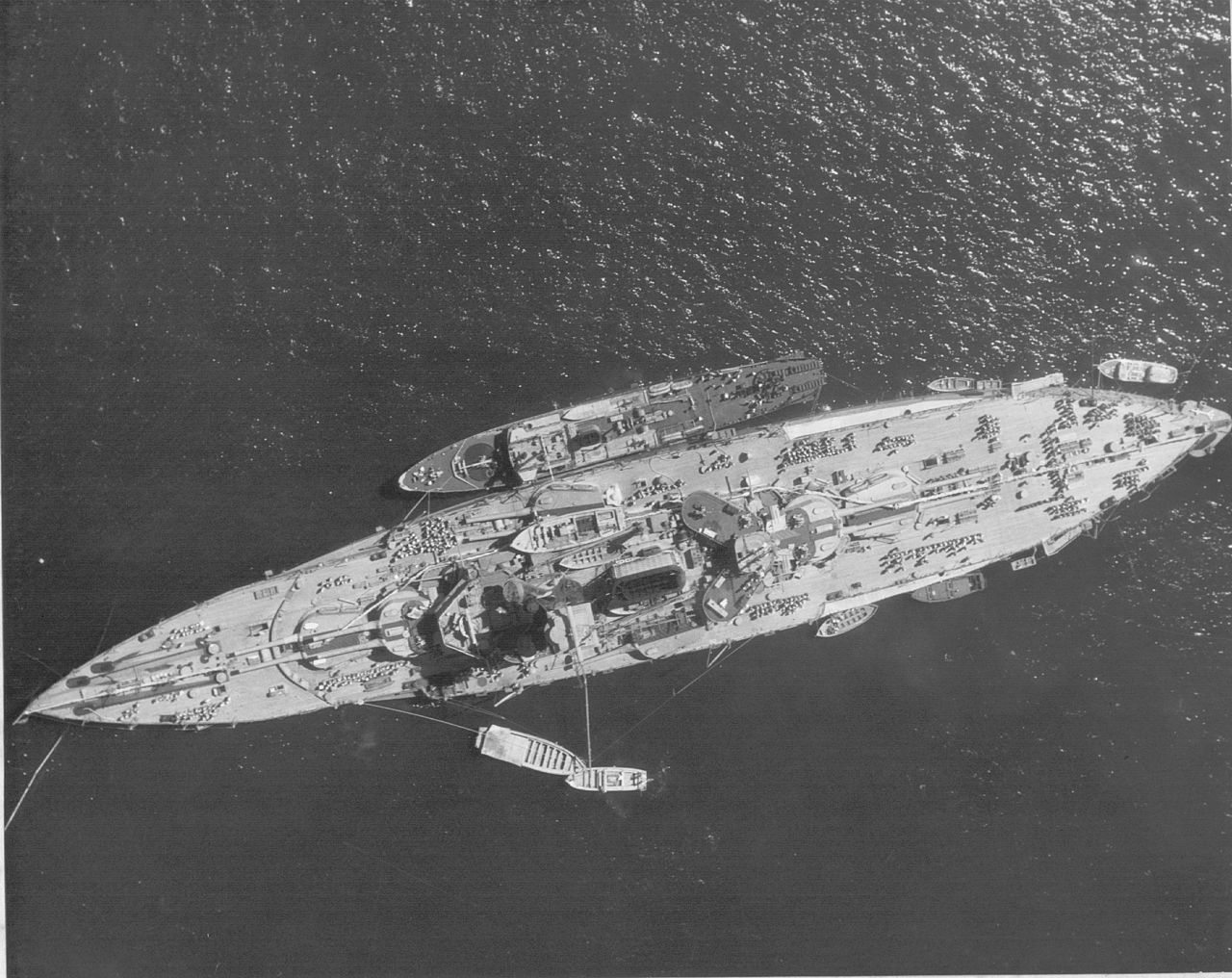Tropic of Capricorn:
Brazil’s
First Dreadnoughts
By Mike Bennighof, Ph.D.
July 2020
 When the British Dreadnought appeared in 1906, Brazil had three small pre-dreadnought battleships under construction in the British shipyards. The Brazilians ordered work halted on 7 January 1907 and on 20 February they approved a new design for them and signed a contract. When the British Dreadnought appeared in 1906, Brazil had three small pre-dreadnought battleships under construction in the British shipyards. The Brazilians ordered work halted on 7 January 1907 and on 20 February they approved a new design for them and signed a contract.
The ships became much larger and now carried a dozen 12-inch guns in place of their 10-inch main battery. They also became much more expensive; the new contract stipulated that two ships would be re-started to the new design, while the third would be laid down as soon as the first was complete. Minas Geraes started over in April and Sao Paulo in September.
Whether the ships represented an increase in fighting power over Dreadnought was debated even at the time, and definitely seems questionable now. They were indeed larger (19,200 tons and 543 feet long for the Brazilian ships vs. 18,100 tons and 527 feet for Dreadnought). The Brazilian design had greater firepower, with 12 guns to 10, with ten guns firing on a Brazilian broadside and eight on a British one. Both were rated for the same relatively high speed, 21 knots, but the British ship had much better protection, with an armor belt of 11 inches against 9 inches in the Brazilian ships. Even so, Britain’s Director of Naval Construction was unhappy with Dreadnought’s armor scheme and hoped for thicker plating on future battleships.
The new Brazilian design suffered from not truly being original: The builders had been instructed to make use of the materials already collected for the earlier battleship design. Thus, the new ships were doomed to carry the same thickness of belt armor as the ships first ordered: small pre-dreadnoughts based on the Chilean Constitucion (later the British Swiftsure).
Construction moved along rapidly, but a ship-fitter’s strike stopped work on both for the first half of 1908. Armstrong’s launched Minas Geraes in September 1908, but Sao Paulo did not slide down the ways at Vickers until the following April. The British shipbuilders blamed the Brazilians for slowness in approving progress, and suspected that an inability to pay for the ships lay behind a deliberate stall. In the fall of 1908 commodity prices for coffee and rubber began to slide under pressure from African and Asian competition, respectively. An attempt for float a new loan for £15 million failed, and Brazil risked default on her battleships.
 Sao Paulo crawls toward New York, 1918. Sao Paulo crawls toward New York, 1918.
Her financiers, the Rothschild’s banking house, suggested selling one of the battleships to the Royal Navy. Armstrong’s signaled agreement if the Brazilians used the proceeds to fund construction of the promised third battleship. The “Navy Scare” of 1909, marked by Unionist demands in Parliament for eight rather than four dreadnoughts in the new naval bill, seemed to make the time right for a sale.
Armstrong’s board of directors, however, feared that a sale to the Royal Navy would get Brazil out of the dreadnought market entirely or worse, send her to another shipyard for replacements. They apparently used their influence to convince the British Admiralty that the battleships were not suitable for the Royal Navy, pointing out their origins as enlarged versions of the greatly disliked Triumph-class pre-dreadnoughts. The campaign proved a triumph of perception manipulation, pressing the image of the ships as the world’s most powerful yet at the same time claiming them not good enough for British service. Thus, despite a desire to sell, and a political situation ripe for a quick sale at an inflated price, the Brazilians ended up keeping their unwanted ships.
Minas Geraes joined the Brazilian fleet in January 1910 and her sister arrived in July. The international naval press gave the Brazilians all the positive coverage for which they had hoped. “Never has the Navy of a minor power,” opined the British journal The Navy League Annual, “loomed so large on the international horizon as that of Brazil during the past year.” Building dreadnoughts, in the eyes of commentators, even outweighed Japan’s naval victory over the Russians five years earlier.
The satisfaction wouldn’t last long. On the evening of 22 November, mutinies broke out on both battleships while at their usual base in Rio de Janeiro. The new ships required much larger crews than previous Brazilian warships, 900 men each. Their captains tried to work them into shape with extraordinarily harsh discipline, and that treatment combined with the Brazilian Navy’s low pay scale and poor rations led to widespread discontent. Though Armstrong’s did not yet know it, the Brazilian naval program was dead. The government began quietly seeking to dispose of its two battleships but would not be successful.
Brazil declared war on the Central Powers in October 1917. Both battleships had deteriorated badly in just eight years, and before Brazilian desires to send them to join the Grand Fleet could be realized they required major overhauls. The war was long over before even the first of the battleships was declared fit for service. Another mutiny followed in 1924.

Minas Geraes after her (real-world) reconstruction.
Minas Geraes was converted to burn oil during a 1931–35 reconstruction. Sao Paulo’s condition would not allow a similar change, but she was modernized less thoroughly between 1934 and 1937. During the Second World War the battleships proved nearly useless, being relegated to harbor defense roles. Sao Paulo was scrapped in 1951 and her sister in 1953. The battleships had wasted Brazilian resources for over forty years, having contributed to rebellions but little else.
While the ships’ condition is usually attributed to poor maintenance practices by their Brazilian crews, the repeated machinery breakdowns raise the question of quality control at their builders. Unlike most dreadnoughts, the two Brazilian ships had older-model triple-expansion engines rather than turbines, and they never worked properly.
In our Second Great War story, the two ships returned to the United States during the 1930’s to receive the re-construction they needed to become even marginally-effective fighting ships. Their power plants were completely removed along with their wing turrets, with new oil-fired boilers and geared turbines installed to raise their speed above its former standard of “garbage scow.” In place of the two amidships gun turrets they received eight twin gunhouses for the ubiquitous American 5-inch/38-caliber dual-purpose guns.
 With sixteen of those very effective 5-inch guns plus numerous 40mm Bofors and 20mm Oerlikon mounts, the Brazilian battleships have a formidable anti-aircraft battery, even as their main battery has been reduced from a dozen to just eight 12-inch guns. They’re very suitable convoy escorts, but remain very old and small ships, standing no chance of success in a surface engagement with a new fast battleship. With sixteen of those very effective 5-inch guns plus numerous 40mm Bofors and 20mm Oerlikon mounts, the Brazilian battleships have a formidable anti-aircraft battery, even as their main battery has been reduced from a dozen to just eight 12-inch guns. They’re very suitable convoy escorts, but remain very old and small ships, standing no chance of success in a surface engagement with a new fast battleship.
Click here to order Tropic of Capricorn (Playbook edition) right now!
Sign up for our newsletter right here. Your info will never be sold or transferred; we'll just use it to update you on new games and new offers.
Mike Bennighof is president of Avalanche Press and holds a doctorate in history from Emory University. A Fulbright Scholar and NASA Journalist in Space finalist, he has published an uncountable number of books, games and articles on historical subjects; a few of them were actually good.
He lives in Birmingham, Alabama with his wife, three children and his dog, Leopold. Leopold enjoys gnawing his deer antler and editing Wikipedia pages.
Want to keep Daily Content free of third-party ads? You can send us some love (and cash) through this link right here.
|
